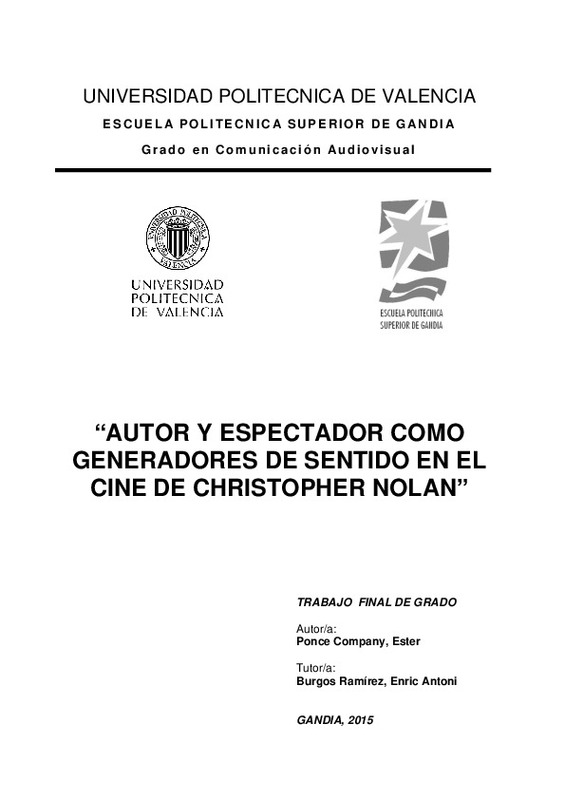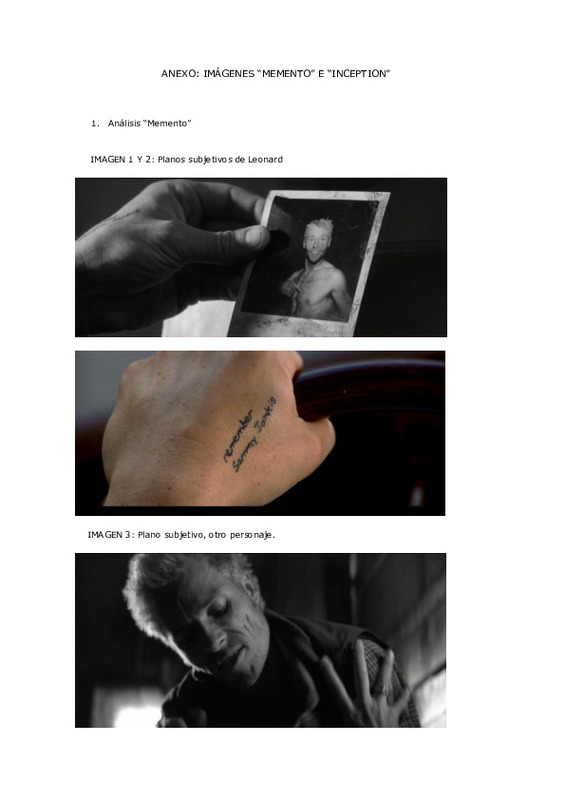JavaScript is disabled for your browser. Some features of this site may not work without it.
Buscar en RiuNet
Listar
Mi cuenta
Estadísticas
Ayuda RiuNet
Admin. UPV
Autor y espectador como generadores de sentido en el cine de Christopher Nolan
Mostrar el registro sencillo del ítem
Ficheros en el ítem
| dc.contributor.advisor | Burgos Ramírez, Enric Antoni
|
es_ES |
| dc.contributor.author | Ponce Company, Ester
|
es_ES |
| dc.date.accessioned | 2015-10-19T17:03:07Z | |
| dc.date.available | 2015-10-19T17:03:07Z | |
| dc.date.created | 2015-09-15 | |
| dc.date.issued | 2015-10-19 | es_ES |
| dc.identifier.uri | http://hdl.handle.net/10251/56228 | |
| dc.description.abstract | Investigación de los recursos tanto narrativos como expresivos empleados en la narrativa audiovisual de las obras cinematográficas de Christopher Nolan. En primer lugar, el documento consiste en describir la forma en la que el director presenta y estructura sus películas, además del lenguaje del que se sirve para conseguirlo. Más tarde se abrirá el debate sobre la necesidad del “cine de autor” y en la creación de un autor implícito o no. Una forma alejada en cierta medida de los cánones del cine Hollywoodiense, los cuales nos tienen acostumbrados a películas por encargo. La consecuencia, un cine impersonal donde la huella del autor es tan débil que en muchos casos no llega a percibirse. Se analizarán algunos de los recursos narrativos más relevantes en el cine de Christopher Nolan: El papel esencial del espectador implícito como generador de sentido y el dominio que ejerce de la focalización y dosificación de la información en el relato. Otro de los principales recursos utilizados es la percepción psicológica de los personajes que demanda la audiencia, cada vez más complejos y heterogéneos. Además se hablará del tiempo y el espacio narrativos, puesto que Christopher Nolan ejerce un gran dominio sobre estas coordenadas. Por último, y como reflexión final, la narrativa no lineal como creadora de los “mind game films” formulando rompecabezas que el espectador deberá resolver. Por lo tanto a través de lecturas de autores de renombre se profundizará en cada concepto para más tarde analizarlo a través de su filmografía, en concreto en dos de sus obras más relevantes Memento e Inception aplicando los conocimientos de los autores, junto al criterio propio, extrayendo así novedosas conclusiones. | es_ES |
| dc.description.abstract | Analysis of the narrative and expressive resources that the director Christopher Nolan used in his two most famous films Memento and Inception. Firstly the document describes how the director introduces and designs the structure of these two films, and the language resources he uses in order to do so. Then, it opens the debate about the "auteur cinema" and about the necessity of an implicit author. The "auteur cinema" is a different way of making films, far away from the Hollywood cinema cannons, where the directors do not make the films that they want, but they just do it as a project on request. The consequence is an impersonal cinema, where it is almost impossible to realize who the director is. It also analyzes the most relevant narrative resources in the Christopher films: The essential role of the viewer as sense generator, the director dominance in the information focusing and its dosage along the film. Another of the main resources is the psychological perception of the more and more complex and heterogeneous characters that audiences ask for. In addition, the essay will deal with narrative time and space, because Christopher Nolan is a reference in these two fields. Last but not least, the paper reflects on the non-lineal narrative. This narrative leads to "mind game films" which create jigsaw puzzles that the viewer must solve. The paper will try to offer some insight through well-known authors’ readings, applying their concepts to the study of Memento and Inception and reaching well-based conclusions. | es_ES |
| dc.format.extent | 50 | es_ES |
| dc.language | Español | es_ES |
| dc.publisher | Universitat Politècnica de València | es_ES |
| dc.rights | Reserva de todos los derechos | es_ES |
| dc.subject | Audiovisual language | es_ES |
| dc.subject | Audiovisual narrative | es_ES |
| dc.subject | Christopher Nolan | es_ES |
| dc.subject | Espectador | es_ES |
| dc.subject | Montaje cinematográfico | es_ES |
| dc.subject | Lenguaje audiovisual | es_ES |
| dc.subject | Metacine | es_ES |
| dc.subject | Autor | es_ES |
| dc.subject | Narrativa audiovisual | es_ES |
| dc.subject.classification | COMUNICACION AUDIOVISUAL Y PUBLICIDAD | es_ES |
| dc.subject.other | Grado en Comunicación Audiovisual-Grau en Comunicació Audiovisual | es_ES |
| dc.title | Autor y espectador como generadores de sentido en el cine de Christopher Nolan | es_ES |
| dc.type | Proyecto/Trabajo fin de carrera/grado | es_ES |
| dc.rights.accessRights | Abierto | es_ES |
| dc.contributor.affiliation | Universitat Politècnica de València. Escuela Politécnica Superior de Gandia - Escola Politècnica Superior de Gandia | es_ES |
| dc.contributor.affiliation | Universitat Politècnica de València. Departamento de Comunicación Audiovisual, Documentación e Historia del Arte - Departament de Comunicació Audiovisual, Documentació i Història de l'Art | es_ES |
| dc.description.bibliographicCitation | Ponce Company, E. (2015). Autor y espectador como generadores de sentido en el cine de Christopher Nolan. Universitat Politècnica de València. http://hdl.handle.net/10251/56228 | es_ES |
| dc.description.accrualMethod | TFGM | es_ES |
| dc.relation.pasarela | TFGM\30817 | es_ES |
Este ítem aparece en la(s) siguiente(s) colección(ones)
-
EPSG - Trabajos académicos [5004]
Escuela Politécnica Superior de Gandia







